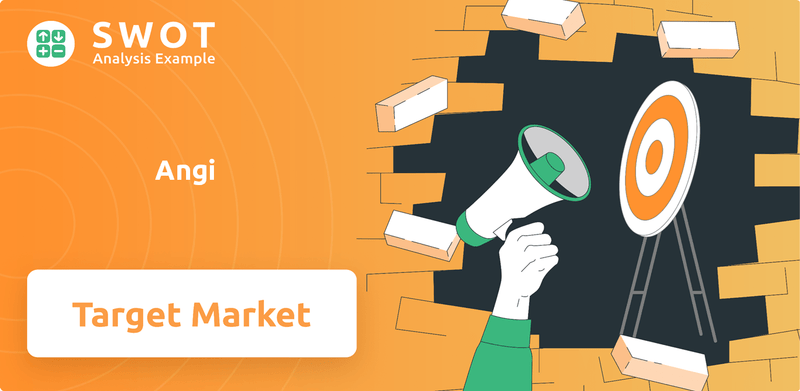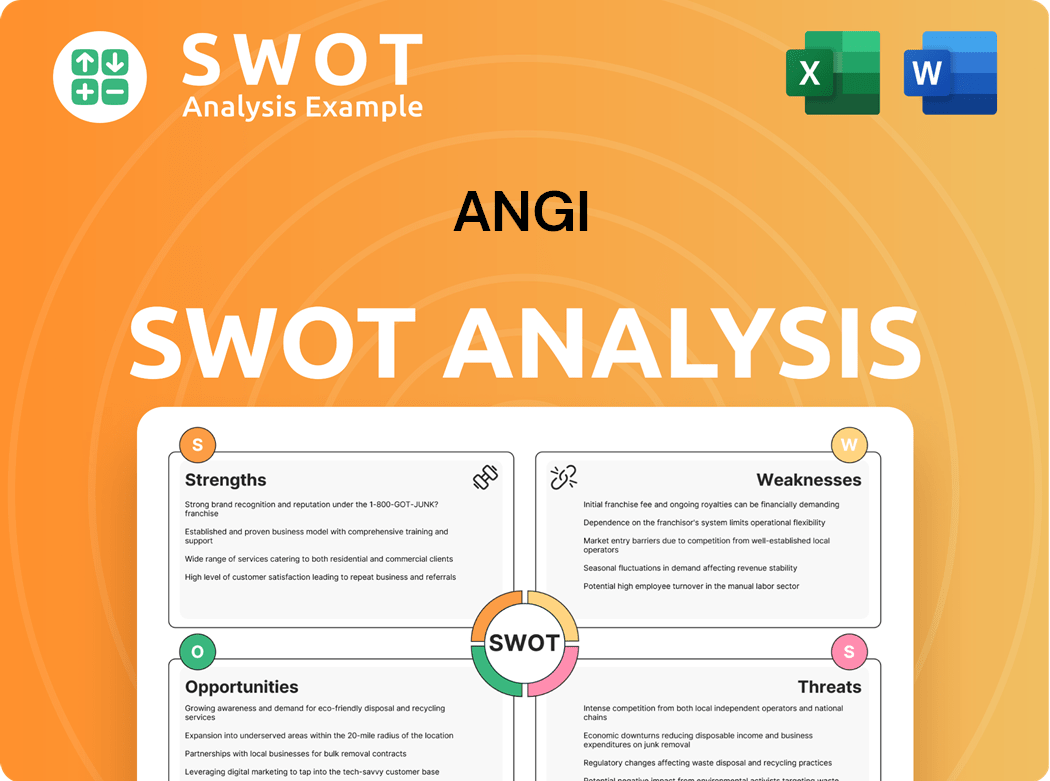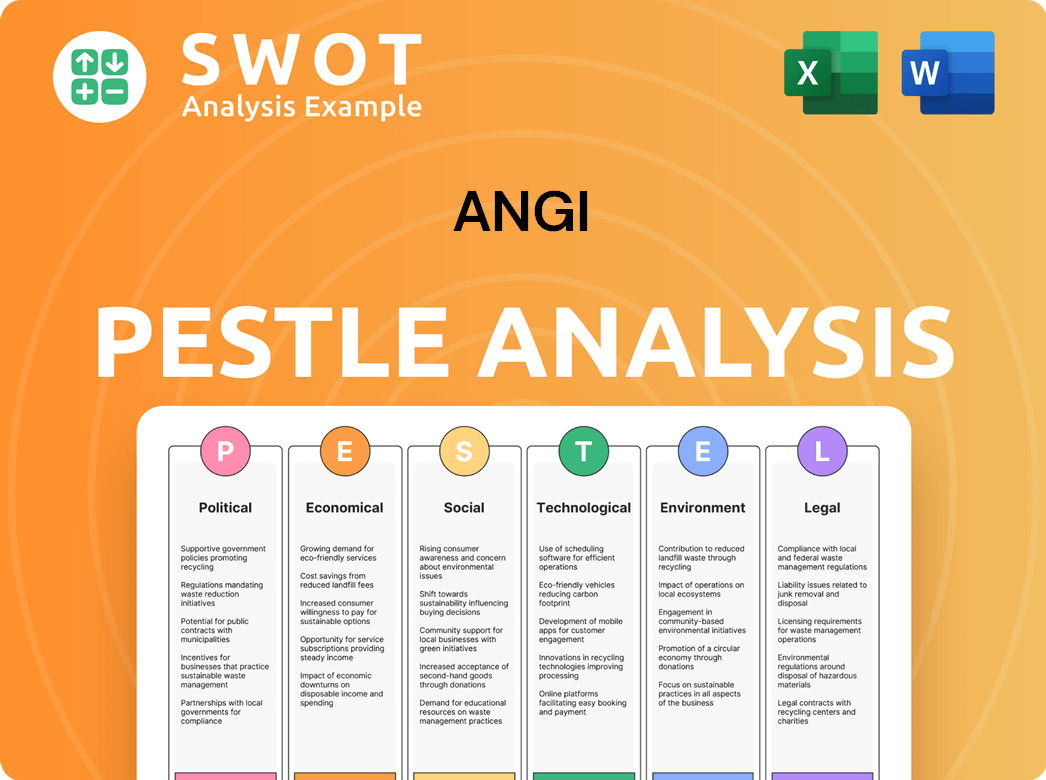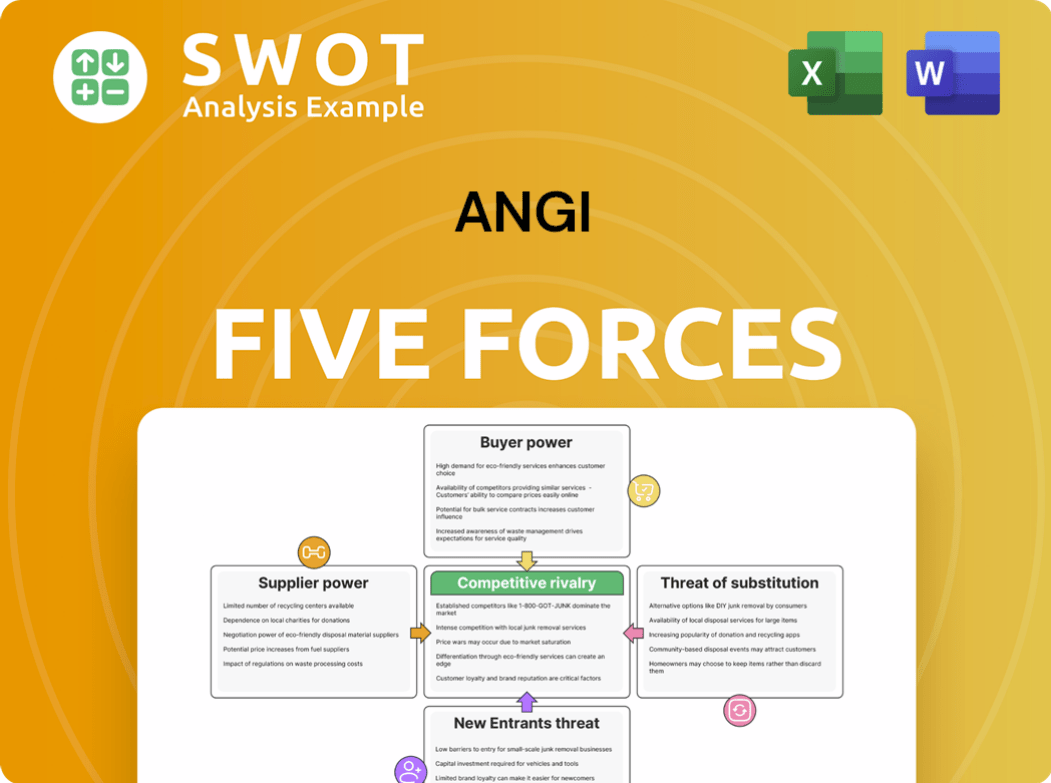Angi Bundle
Who Does Angi Serve?
In the ever-changing landscape of home services, understanding the Angi SWOT Analysis is crucial for success. This analysis delves into the core of Angi's operations, examining its evolution from Angie's List to a modern, consumer-focused platform. This transformation highlights the importance of knowing the Angi target market and adapting to meet their needs.

This exploration will uncover the customer demographics of Angi company, providing insights into who Angi users are, their geographical locations, income levels, and behaviors. We'll also examine how Angi strategically defines its Angi audience and tailors its services to meet the diverse needs of its Angi customer profile, ultimately revealing how Angi acquires and retains its customer base in a competitive market.
Who Are Angi’s Main Customers?
The Angi company primarily focuses on two main customer segments: consumers and service professionals. This dual approach forms the core of its business model as a digital marketplace. Understanding the customer demographics and target market is crucial for Angi's strategic planning and operational success.
On the consumer side, Angi's primary target market consists of homeowners. These individuals typically fall within the age range of 35 to 65 years old and have middle to high income levels. They are actively seeking reliable and vetted professionals for home repair, maintenance, and improvement projects. These Angi users value convenience, trust, and quality in their service providers.
For its B2B segment, Angi targets small to medium-sized businesses (SMBs) and independent contractors in the home services industry. These professionals utilize Angi's platform for lead generation, brand visibility, and business management tools. The characteristics of this segment include a desire for consistent work, efficient customer acquisition, and effective marketing solutions.
The customer demographics of Angi's customers reveal a diverse group. While specific breakdowns are not always public, industry trends suggest a broad appeal across various household types. This includes families and empty-nesters who are actively managing their properties. Angi's customer profile is also shaped by its service offerings.
- Consumer Demographics: Homeowners aged 35-65, middle to high income, seeking home services.
- Professional Demographics: SMBs and independent contractors in home services, seeking leads and business tools.
- Market Expansion: The shift to a freemium model broadened the Angi audience, attracting a younger, more digitally native demographic.
- Geographic Data: Angi's customer location data shows a wide reach across the United States, with a strong presence in urban and suburban areas.
Angi SWOT Analysis
- Complete SWOT Breakdown
- Fully Customizable
- Editable in Excel & Word
- Professional Formatting
- Investor-Ready Format

What Do Angi’s Customers Want?
Understanding the needs and preferences of the Angi company's customer base is crucial for its success. The customer demographics and the Angi target market are primarily driven by the need for reliable and efficient home service solutions. This involves a deep dive into what motivates Angi users and how the platform caters to their specific requirements.
For B2C customers, the primary motivations include convenience, quality assurance, and transparent pricing. The platform simplifies the process of finding qualified professionals, ensuring peace of mind for homeowners. The purchasing behavior involves researching providers, reading reviews, and comparing quotes before making a decision.
Angi's platform addresses common pain points such as finding reputable professionals and uncertainty about fair pricing. Customer feedback, often collected through reviews, directly influences product development, leading to features like instant booking and dispute resolution services. This focus on customer satisfaction is a key element of the Angi customer profile.
Customers are motivated by convenience, quality, and transparent pricing. They seek reliable professionals and assurance of good work. This drives their search and decision-making process on the platform.
Reputation, responsiveness, and value for money are key decision-making factors. Customers heavily rely on reviews and comparisons. The platform's features directly address these criteria.
Usage ranges from urgent repairs to planned renovations. Customers often return for ongoing maintenance or new projects. The platform supports diverse home service needs.
Loyalty is tied to consistent quality, ease of booking, and effective problem resolution. Positive experiences lead to repeat business. The platform prioritizes customer satisfaction.
Customers seek peace of mind and the aspiration for a well-maintained home. They value the relief of delegating complex tasks. The platform addresses these emotional needs.
Practical drivers include saving time, ensuring safety, and achieving desired outcomes for home projects. The platform streamlines these practical aspects. Angi simplifies the process.
Angi's platform simplifies the search process by offering categorized services and filtering options to match specific customer needs. For example, a detailed analysis of the Marketing Strategy of Angi can reveal how the company tailors its approach to different customer segments. The marketing emphasizes the ease and reliability of connecting with vetted professionals, directly addressing the pain points of homeowners.
Customers need reliable, efficient, and trustworthy home service solutions. They want convenience, quality assurance, and transparent pricing. The platform is designed to meet these needs effectively.
- Finding qualified professionals is a primary need.
- Assurance of quality work is a key driver.
- Transparency in pricing builds trust.
- Ease of booking and scheduling are essential.
Angi PESTLE Analysis
- Covers All 6 PESTLE Categories
- No Research Needed – Save Hours of Work
- Built by Experts, Trusted by Consultants
- Instant Download, Ready to Use
- 100% Editable, Fully Customizable

Where does Angi operate?
The primary geographical market for the home services platform is the United States. The company operates across major metropolitan areas, extending its reach to smaller towns and rural communities. Its strong presence is particularly noticeable in densely populated areas where demand for home services is consistently high.
The home services platform's brand recognition is strongest in regions where it has had a robust presence. This is especially true under its former identity. While specific market share data by city or region is proprietary, the company's long-standing presence and extensive network of service professionals suggest a strong foothold in these areas.
While the company's core operations are concentrated in the U.S., it has explored international markets. However, its current focus remains predominantly domestic. The company's strategy involves deep penetration within the U.S. market, leveraging its established network and brand to capture a larger share of the fragmented home services industry.
The platform localizes its offerings by allowing service professionals to set their service areas. This ensures that users are connected with local providers. This approach helps in catering to the specific needs of each region and ensures efficient service delivery.
Marketing efforts may also be localized to address specific regional needs or cultural nuances. For instance, promotional campaigns in the Northeast might highlight winterizing services. Campaigns in the Sun Belt could focus on air conditioning maintenance, showing a tailored approach to customer needs.
Differences in customer demographics and preferences across U.S. regions can influence service demand. Areas with older housing stock may have higher demand for repair services. Rapidly growing suburban areas might see more renovation projects. Understanding these regional variations is key to the company's market strategy.
- The platform's localized approach helps in reaching its target market effectively.
- Regional marketing campaigns are designed to address the specific needs of the local customer base.
- The company's focus on the U.S. market allows for deeper penetration.
- The company's customer acquisition strategy is built on understanding regional differences.
Angi Business Model Canvas
- Complete 9-Block Business Model Canvas
- Effortlessly Communicate Your Business Strategy
- Investor-Ready BMC Format
- 100% Editable and Customizable
- Clear and Structured Layout

How Does Angi Win & Keep Customers?
The company, formerly known as Angie's List, employs a comprehensive strategy for acquiring and retaining customers. Their approach combines digital and traditional marketing methods to reach a broad audience. This multi-faceted strategy is designed to build brand awareness and encourage customer loyalty.
Customer acquisition focuses on digital marketing, including search engine optimization (SEO), paid search advertising (PPC), and social media marketing. Content marketing, through blog posts and guides, also plays a role in attracting potential customers. Traditional advertising, such as TV and radio commercials, has historically contributed to brand awareness, although digital channels are now more dominant. Referral programs and partnerships with related industries contribute to new customer acquisition.
Retention strategies center on enhancing the customer experience and fostering loyalty. This includes personalized email marketing, customer data analysis, and loyalty programs. After-sales service, including customer support and dispute resolution, is critical for building trust and ensuring customer satisfaction, which directly impacts retention and positive word-of-mouth referrals.
Digital marketing is a cornerstone of the company's customer acquisition strategy. SEO helps the company rank highly in search results for home service-related queries. Paid search advertising, such as Google Ads, targets users actively seeking services.
Content marketing, including blog posts and guides on home improvement, attracts potential customers. Social media marketing across platforms like Facebook, Instagram, and TikTok reaches homeowners. These efforts provide value and build brand awareness.
Traditional advertising, such as TV and radio commercials, historically contributed to brand awareness. Referral programs and partnerships with related industries, like real estate, contribute to new customer acquisition. These channels complement digital efforts.
Personalized email marketing campaigns based on past service history and expressed interests encourage repeat business. Customer data and CRM systems are used to segment the audience and tailor marketing messages. This improves engagement.
The company emphasizes customer experience and loyalty through personalized marketing, loyalty programs, and robust after-sales service. The transition to a freemium model was a strategic shift aimed at increasing customer acquisition. This change, coupled with a focus on seamless digital interactions, has aimed to improve customer lifetime value.
- Customer Segmentation: The company uses customer data to segment its audience for targeted marketing.
- Loyalty Programs: Discounts and exclusive features are often integrated to reward frequent users.
- After-Sales Service: Customer support and dispute resolution are critical for building trust.
- Seamless Digital Interactions: The platform focuses on ease of booking and project management tools.
The company's strategic shifts, including the move to a freemium model and a focus on digital interactions, aim to improve customer lifetime value and reduce churn rates. For more insights, you can read about the Growth Strategy of Angi.
Angi Porter's Five Forces Analysis
- Covers All 5 Competitive Forces in Detail
- Structured for Consultants, Students, and Founders
- 100% Editable in Microsoft Word & Excel
- Instant Digital Download – Use Immediately
- Compatible with Mac & PC – Fully Unlocked

Related Blogs
- What are Mission Vision & Core Values of Angi Company?
- What is Competitive Landscape of Angi Company?
- What is Growth Strategy and Future Prospects of Angi Company?
- How Does Angi Company Work?
- What is Sales and Marketing Strategy of Angi Company?
- What is Brief History of Angi Company?
- Who Owns Angi Company?
Disclaimer
All information, articles, and product details provided on this website are for general informational and educational purposes only. We do not claim any ownership over, nor do we intend to infringe upon, any trademarks, copyrights, logos, brand names, or other intellectual property mentioned or depicted on this site. Such intellectual property remains the property of its respective owners, and any references here are made solely for identification or informational purposes, without implying any affiliation, endorsement, or partnership.
We make no representations or warranties, express or implied, regarding the accuracy, completeness, or suitability of any content or products presented. Nothing on this website should be construed as legal, tax, investment, financial, medical, or other professional advice. In addition, no part of this site—including articles or product references—constitutes a solicitation, recommendation, endorsement, advertisement, or offer to buy or sell any securities, franchises, or other financial instruments, particularly in jurisdictions where such activity would be unlawful.
All content is of a general nature and may not address the specific circumstances of any individual or entity. It is not a substitute for professional advice or services. Any actions you take based on the information provided here are strictly at your own risk. You accept full responsibility for any decisions or outcomes arising from your use of this website and agree to release us from any liability in connection with your use of, or reliance upon, the content or products found herein.